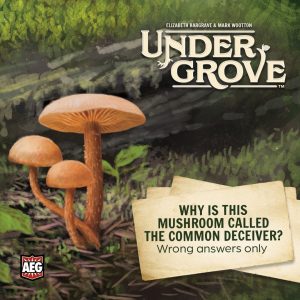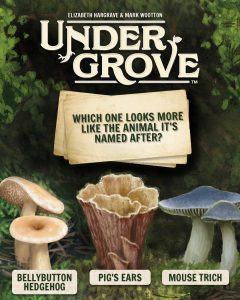It has many names: The mid-campaign slump, doldrums, slog, etc. If you’ve run a crowdfunding campaign, you know what I’m talking about: Most projects attract backers during the first 48 hours and the last 48 hours. Everything else in between is a major challenge.
Yet the middle of the campaign is its heart. Those 20 or so days are often the difference between a mildly successful project and a wildly successful project, both in terms of the quality of the product itself and how appealing it is when thousands of backers receive their final notification.
I wrote about this subject in 2014 (see the original article here), but that’s a long time ago, so today I’m revisiting the subject with some insights from AEG’s John Zinser, who is currently in the middle of their Kickstarter campaign for Elizabeth Hargrave’s new game, Undergrove.
Before the Doldrums
- shorter campaign: One way to reduce the doldrums is to run a shorter campaign. I completely understand the value of first-time creators running 25-30 day campaigns to get their sea legs, but repeat creators can close the gap by running 18-24 day campaigns. I think this is particularly viable in an age of pledge managers, as projects continue to attract thousands of preorder customers after the crowdfunding campaign ends.
- send review/preview copies: If you wait until the campaign begins to find content creators willing to accept your prototype, it may be too late. Some of these reviews/previews can be available before the project launches and on launch day, but it’s helpful to stagger some of this third-party content to appear in the middle of the campaign.
- prepare for daily content: Create a plan in advance for one big thing to reveal, showcase, or execute every day (the types of things discussed below). The key here is that you have a plan in advance so you don’t end up frontloading everything.
During the Doldrums
For most of the ideas on this list, I think the key in today’s crowdfunding landscape is to use every platform available to you. For example, if you run a poll or ask a silly question, don’t just do it in a project update: Do it on some combination of Facebook, Instagram, YouTube, TikTok, BoardGameGeek, your company blog, your newsletter, etc.
- ask for and implement feedback: One of the best aspects of crowdfunding isn’t the funding–it’s the crowd. With a wealth of passionate people at your fingertips and an open mind, you can learn so much about how to refine your project page, improve the stretch goals, add-ons, and other rewards, and enhance product itself. If you expand add-on options or improve any top-tier rewards, it’s worth informing lower-tier backers of the changes (Kickstarter lets you send messages to all backers at each reward level).
- pre-advertised surprises: On his Sleeping Gods: Distant Skies campaign, Ryan Laukat planned a few big surprises in advance. Backers knew when they were coming but didn’t know what they were until the day of the reveal. As a backer myself, I can say I’ve never clicked on a project update email faster than when those surprise notifications arrived in my inbox.
- voting, brackets, polls, surveys: As AEG’s John Zinser mentioned to me, “People love to vote and rank things. For Undergrove we recently discovered that the upgraded wood tiles are nearly indestructible. As a running gag we tried different ways to destroy them and someone suggested that we should make coasters out of them. So we are running brackets to determine which pieces of art will go on a coaster set that will be made from the same wood as the upgraded tiles. These are now an inexpensive add-on for backers who want them.”
 focus social media posts on interaction: A rule of thumb for any social media post is that you’ll open the door to comments if you ask a question. One of the reasons I asked John for his thoughts on this topic is because I’ve seen a lot of creative posts from the Undergrove team like the image shown here. Having posts like this geared towards engagement instead of sales is great.
focus social media posts on interaction: A rule of thumb for any social media post is that you’ll open the door to comments if you ask a question. One of the reasons I asked John for his thoughts on this topic is because I’ve seen a lot of creative posts from the Undergrove team like the image shown here. Having posts like this geared towards engagement instead of sales is great.- send a few updates to newsletter subscribers and backers of previous projects: Again, make sure to spread out these updates, as you don’t want the same person to get 5 emails from you on the same day. If you reach out to backers of past projects, I recommend only selecting related projects (e.g., for a heavy sci-fi game, don’t solicit backers from your filler game about kittens).
- stretch goals, daily goals/reveals, component highlights: This ties into the plan you created before launching for having something exciting to showcase every day. If you use stretch goals to unlock new content, you can’t control how fast the goals are reached, but you can control how and when you spotlight that content (even if it’s already unlocked).
- post third-party playthroughs, reviews, interviews: Even if your original batch of prototype reviewers have already posted their content, they may want to bolster that content with playthroughs and interviews. If not, you could cover shipping for those prototypes to be sent to other content creators.
- create liveplays, design diaries, and puzzles: There’s so much content you can create without relying on third-party creators. You can liveplay the game (encouraging viewers to influence decisions). You can post design diaries telling the story of the game’s creation (I do this for our games, using these posts to reveal components and mechanisms). And you can offer puzzles for people to solve; Cardboard Alchemy excels at this.
- run ads promoting success and timelines: Most of this list is comprised of completely free ideas–they require time and energy, but not money. But it’s also okay to have a budget for ads (social media and banner ads on BGG). For these ads, I recommend that they focus on urgency (when the project will end) and success (funding level, # of backers, # of stretch goals unlocked, etc–people want to know what everyone else is excited about before it’s too late).
 John also spoke about the emotional impact that the mid-campaign slump can have on the creator and their team. It’s tough to see a project that you put so much love into only attracting a few new backers each day (even if the project is already doing quite well thanks to the first 48 hours). He says, “We have found that-mid campaign pushes that are fun to do also invigorate the team who has worked long hard hours to get to the campaign and by mid campaign have a bit of battery drain happening. After over a year of hard work, meetings about things that are not super stressful and just creative to interact with are a bonus for everyone.”
John also spoke about the emotional impact that the mid-campaign slump can have on the creator and their team. It’s tough to see a project that you put so much love into only attracting a few new backers each day (even if the project is already doing quite well thanks to the first 48 hours). He says, “We have found that-mid campaign pushes that are fun to do also invigorate the team who has worked long hard hours to get to the campaign and by mid campaign have a bit of battery drain happening. After over a year of hard work, meetings about things that are not super stressful and just creative to interact with are a bonus for everyone.”
This post is also a great reminder for me to implement more of these methods whenever I reveal a new product, as they still apply to our current method (make a game, reveal it over 1-2 weeks, then launch/ship it a few weeks later).
I appreciate John adding his thoughts in the context of Undergrove, and I’d also love to hear your thoughts about overcoming the mid-campaign slump. What have you done as a creator or seen projects do during that time to entice you to back them?
***
If you gain value from the 100 articles Jamey publishes on this blog each year, please consider championing this content! You can also listen to posts like this in the audio version of the blog.
4 Comments on “12 Ways to Overcome the Mid-Campaign Doldrums”
Leave a Comment
If you ask a question about a specific card or ability, please type the exact text in your comment to help facilitate a speedy and precise answer.
Your comment may take a few minutes to publish. Antagonistic, rude, or degrading comments will be removed. Thank you.



Thanks for the Article Jamey! I’m excited to get into this world and I’m mopping up every bit of information I can get.
I just got my first board game idea into writing rather than jumbled messes of thoughts. The next step is researching what it takes to get to the step of having a prototype and eventually running a campaign. Your blogs have been some of the most helpful research in that field, this one included.
Thanks Isaac! I hope you’re having fun with the design process. :)
Really interesting article! Overcoming the mid-campaign doldrums has been on our minds a lot at All About Games Consulting. The pre-advertised surprises is a nice strategy!
As part of a recent campaign we managed for one of our partners, we revealed a mid-campaign “early bird” that had a personal meaning to the designer. This was tied to the Halloween holiday which was thematically appropriate to the game and the early bird item had a 24 hour window for people to back the project to get this exclusive item for free with their pledge.
This, combined with several other contributing marketing activations lead to £15,000 in funding – approximately 6.4% of the campaign’s total – during this 24 hour period, which occurred after the first week of the campaign when we were seeing the typical slowing down in funding. We’ll certainly be considering this approach for future campaigns we help our partners manage!
Thanks for sharing, Tim. Since it’s an “exclusive” item, are people who missed the 24-hour window completely out of luck for the entire future (hopefully many years) of the game?